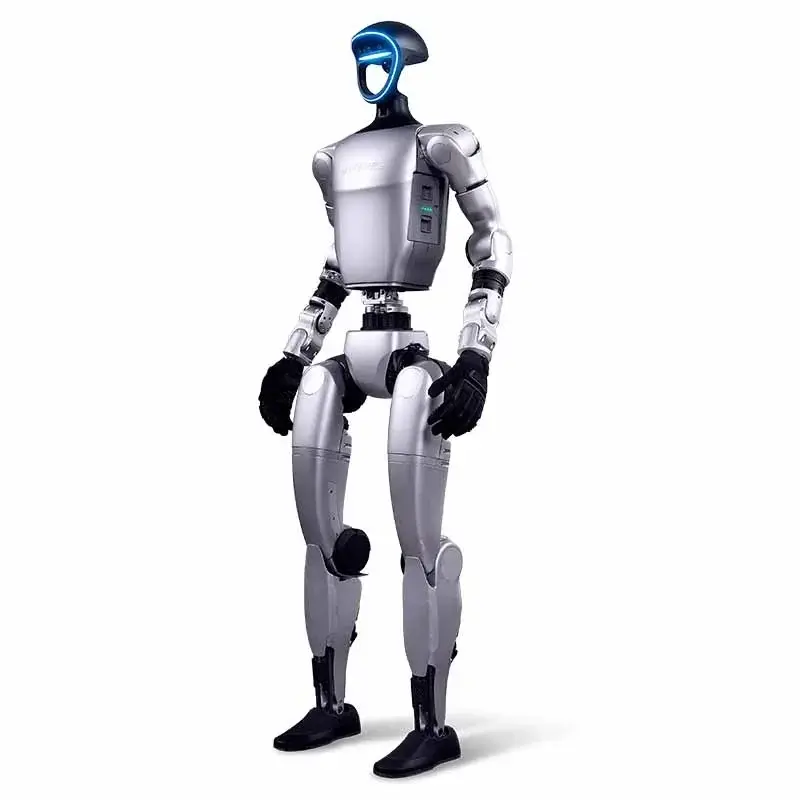Unleashing Precision: A Deep Dive into Fanuc CNC Fundamentals for Manufacturing Excellence
The modern manufacturing world relies on precision, efficiency and repeatability. At the heart of countless workshops and production halls around the world, you’ll find CNC (computer numerical control) machines – robotic marvels that transform digital blueprints into tangible metal, plastic or composite parts. Powering many of these machines, especially high-performance machines, are industry-leading FANUC CNC system. For businesses like this huge lightAs a specialist five-axis CNC machining manufacturer utilizing cutting-edge technology, mastering the basics of Fanuc is not only helpful; This is the basis for delivering the exceptional precision and quality our customers demand. This guide delves into the core concepts of Fanuc CNC, allowing you to understand the technology that drives manufacturing excellence.
Why does FANUC CNC dominate?
Japanese automation giant FANUC is known as the leading force in the field of CNC control. Here’s why:
- Rock-solid reliability: Fanuc systems are known for their durability and uptime. They are designed for harsh manufacturing environments to minimize unplanned downtime – a key factor in high-volume production and critical custom projects.
- Amazing speed and accuracy: FANUC controls can handle complex tool paths at incredible speeds while maintaining excellent positional accuracy. This is critical for the complex geometries and tight tolerances required in aerospace, medical and automotive applications.
- Intuitive (Pro) interface: Although there is a learning curve, the logical structure of the Fanuc interface is consistent across many models. Once mastered, operators and programmers can efficiently navigate menus and functions. Features such as conversational programming manual guidance (iHMI) also simplify simpler tasks.
- Broad compatibility and ecosystem: Fanuc hardware integrates seamlessly with a wide range of machine tools, drives, motors and peripherals. Due to its market dominance, finding knowledgeable support, spare parts, and expert technicians is often easier.
- Advanced features for complex jobs: From high-speed machining cycles and rigid tapping to complex tool management, probing programs and seamless compensation features such as thermal growth and tool wear compensation, FANUC control systems provide the tools needed for complex, high-quality machining.
Interpreting Fanuc CNC Controls: Core Components and Operations
Understanding Fanuc CNC requires breaking down its basic components and workflow:
- Control unit (CNC): This is the brain. It interprets program code (G-code, often enhanced with Fanuc-specific macro functions), calculates precise trajectories, coordinates axis motion and manages input/output signals.
- Operation panel: Physical interface (keyboard, display, buttons) where the operator loads programs, sets offsets (tool length, workpiece origin), controls machine movements (jog, joystick, MDI), monitors operations and handles alarms.
- Servo drives and motors: They convert the CNC’s instructions into physical motion of the machine axes (X, Y, Z and rotational axes, such as A, B, C in a 5-axis machine). Fanuc’s integrated servos are known for their responsiveness and smooth motion control.
- Machine tool interface: Electrical and communication links between the CNC and the mechanical components of the machine (spindle, coolant pump, tool changer, limit switches).
- Program input: Programs (partly written in G-code) are typically loaded via USB, Ethernet, RS-232 serial port, or directly from machine memory. Fanuc often uses its own file extensions, such as
.cncor.nc.
Key FANUC concepts every machinist should master:
- G code and M code: Basic programming language.
- G code: definition Geometric Movements and cycles (for example, G00 – rapid movement, G01 – linear feed movement, G02/G03 – circular interpolation, G81 – drilling cycle).
- M code: control machine Function (for example, M03 – spindle start clockwise, M08 – coolant on, M30 – end of program and reset).
- Offset: Crucial for accuracy:
- Zero offset (G54-G59 and extended): Define the origin of the workpiece (X0, Y0, Z0) in the machine coordinate system on the workbench.
- Tool length offset (H code): Consider the different lengths of the tools in the spindle.
- Tool radius/diameter offset (D code): Compensates the radius/diameter of the tool (critical for contouring).
- Coordinate system:
- Machine Coordinate System (MCS): The absolute starting position defined by the physical limitations of the machine.
- Working coordinate system (WCS): Settings are specific to each workpiece, via workpiece offsets (G54, etc.).
- Modal commands and non-modal commands: Modal commands (such as G01 or M08) remain active until canceled or changed. Non-modal commands only affect the line on which they appear.
- Macro programming (macro B/user macro): Powerful Fanuc functionality allows custom subroutines using variables, calculations, logic (IF/THEN) and loops, enabling highly complex and adaptive programs.
- DNC (direct numerical control): Run large programs directly from an external computer, bypassing limited machine memory.
FANUC in action: Improving Ferrite’s five-axis machining level
for huge lightSpecializes in senior Five-axis CNC machiningFanuc control is indispensable. This is why they are the engine of our success:
- Handle complex geometries: Five-axis machining allows 5 axes to be moved simultaneously, enabling complex cuts of highly contoured surfaces (such as turbine blades, impellers, custom prototypes) in a single setup. FANUC’s precise coordination and powerful interpolation capabilities ensure smooth motion for even the most complex tool paths.
- Unparalleled precision and surface finish: Fanuc’s advanced motion control minimizes vibration and maintains consistent speeds during complex multi-axis movements, which is critical to achieving the perfect surface finish and micron-level tolerances required by our customers.
- Reduce setup time and errors: The ability to machine complex parts from near-net shape using minimal fixtures (due to multiple access angles) greatly reduces setup time and potential errors. Fanuc’s reliable detection system further automates setup and in-process inspections.
- Optimize material removal: Fanuc’s high-speed machining options and efficient path planning enable faster, more aggressive cuts while maintaining tool life and part integrity, which is especially important for demanding metals like titanium or Inconel.
- Proven stability of key components: The reliability of Fanuc hardware ensures our production lines continue to operate, which is critical to delivering critical precision parts on time and to specifications for aerospace, medical and defense applications.
Beyond the basics: Achieve optimal performance with Fanuc
- Proactive maintenance: Perform predictive maintenance with Fanuc’s built-in diagnostic tools and maintenance screens. Don’t wait for the alert! Regular backup of parameters and programs is non-negotiable.
- Embrace macro forces: Investing in advanced programming skills with macros can bring huge benefits in reducing programming time for part families and implementing complex machining strategies.
- Main detection cycle: Fanuc’s spindle probes and tool setters automate critical tasks such as tool breakage detection, part setup verification and in-process inspections. Understand all available probing cycles (e.g., G31) to maximize their benefits.
- Take advantage of the simulation (and verify!): Always use Fanuc’s built-in simulator or offline CAM software to simulate complex programs (especially 5-axis paths) within machine memory limitations. Prevention is better than accident. Rigorous verification is key.
- Stay updated: Keep software and firmware reasonably up to date (check with your machine tool manufacturer). As functionality evolves, consider training on newer Fanuc series, such as the intuitive Fanuc 0i-F series.
Conclusion: Precision Design with Fanuc and GreatLight Expertise
Fanuc CNC systems represent more than just hardware and software; they embody the reliability, precision and power that shape modern manufacturing. Understanding its core principles—from offsets and coordinate systems to the nuances of macro programming and motion control—is the cornerstone of any CNC machinist or programmer striving for excellence.
exist huge lightWith FANUC Controls’ deep expertise, combined with advanced five-axis machining capabilities and cutting-edge technology, we can tackle the most challenging precision metal part manufacturing projects. We don’t just run the machine; we run the machine. We leverage the full potential of Fanuc CNC systems to ensure efficiency, accuracy and repeatability. Our commitment goes beyond machining to provide seamless One-stop post-processing and finishing servicesensuring your parts are delivered fully finished and ready for assembly.
Whether you need complex aerospace parts, complex medical equipment or custom prototypes, take advantage of Fanuc’s precision huge light Guaranteed excellent results. We specialize in quickly customizing precision machining solutions for most materials and delivering them at competitive prices. Experience the difference mastering advanced machinery and basic CNC principles makes – Contact Ferrite today to customize your precision parts.
FAQ: Five-Axis Machining with Fanuc CNC and GreatLight
Q1: Why is FANUC used so widely in CNC machine tools?
A1: FANUC dominates due to its unrivaled reliability, consistent high performance, blazing-fast processing speeds, exceptional precision capabilities, broad compatibility with machine tools, a vast global support network, and power for complex machining tasks. Its proven track record in harsh industrial environments makes it a trustworthy choice.
Q2: What are the main differences between 3-axis and 5-axis CNC machining, and why choose 5-axis?
A2:* 3 axis: Moves the tool along the X, Y, and Z (linear axes). Ideal for prismatic parts. Multiple setups are required for complex geometries, which increases time and potential for errors.
- 5 axis: Adding two axes of rotation (usually A, B, or C) allows the tool to approach the workpiece from almost any direction simultaneously. Benefits include machining complex contours in one setup, significantly reducing setups/errors, achieving superior surface finishes on complex shapes, using shorter tools for better access/stiffness, and optimizing cutting angles for greater efficiency.
Q3: What advantages does Honglaite provide for FANUC’s five-axis machining?
A3: At GreatLight, we combine:
- Advanced Fanuc 5-Axis Equipment: The internationally sourced machinery is equipped with high-precision Fanuc controls, optimized for simultaneous 5-axis motion.
- Engineering expertise: Gain insights into Fanuc programming, macro utilization, and multi-axis toolpath strategies to unlock its full potential.
- Material mastery: Ability to proficiently machine a variety of materials (aluminum, steel, titanium, plastics, composites) to tight tolerances.
- Speed and flexibility: Committed to quick turnaround times and custom solutions.
- End-to-end service: Comprehensive support including machining, surface treatment (anodizing, plating, painting), inspection and assembly.
Q4: How do I choose between FANUC and other CNC controllers (such as Siemens or Heidenhain)?
A4: While Siemens and HEIDENHAIN are excellent competitors, FANUC tends to excel in terms of sheer robustness and market saturation. Manufacturers choose FANUC for its legendary reliability, extensive global parts/service support network, higher processing speeds for many applications, and competitive pricing structure. Siemens may offer more complex automation integration capabilities in specific implementations, while HEIDENHAIN is praised for its user-friendliness and high-precision surface finish. The best choice depends largely on the specific machine type, application complexity, existing infrastructure and manufacturer priorities.
Q5: Is the FANUC system difficult to learn?
A5: FANUC control has specific logic and structure. Operators familiar with the basics of G-code will find the core operations transferable. The interface is powerful, but may initially feel less modern than newer competitor interfaces. While basic operations such as setup and program running can be learned relatively quickly, mastering advanced features such as Macro B programming, effective use of all compensation functions, and troubleshooting complex alarms require considerable dedication and experience. GreatLight invests heavily in operator and programmer training to ensure in-depth proficiency in Fanuc.
Q6: Can GreatLight handle prototypes and low-volume production?
A6: Of course. Five-axis CNC machining, especially with the flexibility provided by Fanuc and advanced CAM software, is ideal for complex prototypes and low- to medium-volume production that require complex geometries. It avoids expensive mold investments common in processes such as molding. Our focus at GreatLight includes providing efficient, high-precision solutions for these scenarios.









































